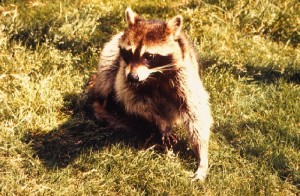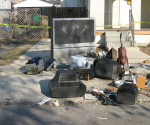What is Baylisascaris procyonis?
Baylisascaris procyonis is a roundworm found in the small intestines of raccoons. They excrete the eggs of this parasite in their feces. The eggs can survive in the environment for years under favorable conditions. There can be millions of eggs shed by the raccoon, with high densities in the feces and the soil surrounding it.
The raccoon roundworm is pretty indiscriminate in what animals it can infect; rabbits, woodchucks, squirrels, and birds amongst others. Many times these animals get infected by getting the eggs in their fur and ingest the eggs during grooming.
Humans also get infected by accidentally ingesting eggs from the environment, from raccoon feces, contaminated water or fomites. Raccoons typically defecate in favored areas called latrines. Common latrines include the bases of trees, raised forks of trees, fallen logs, rooftops, woodpiles and decks.
In animals and humans, the eggs hatch in the intestine and the larvae migrate through the body. The three most common disease manifestations are larval migrations through the tissues, to the eyes (blindness) and the central nervous system (brain damage). Young children and persons with pica, (an abnormal desire to eat strange things like dirt) and those who are exposed to areas where raccoons defecate are most likely to get infected.
Treatment for this parasite is generally ineffective in preventing death. If the treatment is started early enough, it could kill the larva before it enters the central nervous system.
Read more: “Baylisascaris procyonis: the little known but very dangerous raccoon roundworm”
B. procyonis is found in both urban and rural environments. The prevalence varies on geographic area. It is most common in northern areas of the United States and decreases in the southern states, where it is less common in raccoons in the Deep South.
How can you prevent this potentially life-threatening infection? According to the Centers of Disease Control and Prevention the following steps should be followed:
- Avoid direct contact with raccoons — especially their feces. Do not keep, feed, or adopt raccoons as pets! Raccoons are wild animals.
- Discourage raccoons from living in and around your home or parks by preventing access to food
- closing off access to attics and basements
- keeping sand boxes covered at all times, (becomes a latrine)
- removing fish ponds — they eat the fish and drink the water
- eliminating all water sources
- removing bird feeders
- keeping trash containers tightly closed
- clearing brush so raccoons are not likely to make a den on your property
- Stay away from areas and materials that might be contaminated by raccoon feces. Raccoons typically defecate at the base of or in raised forks of trees, or on raised horizontal surfaces such as fallen logs, stumps, or large rocks. Raccoon feces also can be found on woodpiles, decks, rooftops, and in attics, garages, and haylofts. Feces usually are dark and tubular, have a pungent odor (usually worse than dog or cat feces), and often contain undigested seeds or other food items.
- To eliminate eggs, raccoon feces and material contaminated with raccoon feces should be removed carefully and burned, buried, or sent to a landfill. Care should be taken to avoid contaminating hands and clothes. Treat decks, patios, and other surfaces with boiling water or a propane flame-gun. (Exercise proper precautions!) Newly deposited eggs take at least 2-4 weeks to become infective. Prompt removal and destruction of raccoon feces will reduce risk for exposure and possible infection.
This disease is considered uncommon in humans, but it is probably more common than documented. The number of infected raccoons and the increased likelihood humans come into contact with raccoons and their feces makes me believe it may be more prevalent than thought.
For more infectious disease news and information, visit and “like” the Infectious Disease News Facebook page
Looking for a job in health care? Check here to see what’s available
Chagas in Black and White: T-shirts, coffee mugs and other merchandise featuring the parasite Trypanosoma cruzi
Giardia in Black and White: T-shirts, coffee mugs and other merchandise with a clean, computerized image of a Giardia intestinalis trophozoite
















[…] from wild animals to people is a concern. Even when human infections are rare, as in the case of the parasitic roundworm Baylisascaris procyonis, scientists need to learn as much as they can about the parasite that transmits disease and the […]